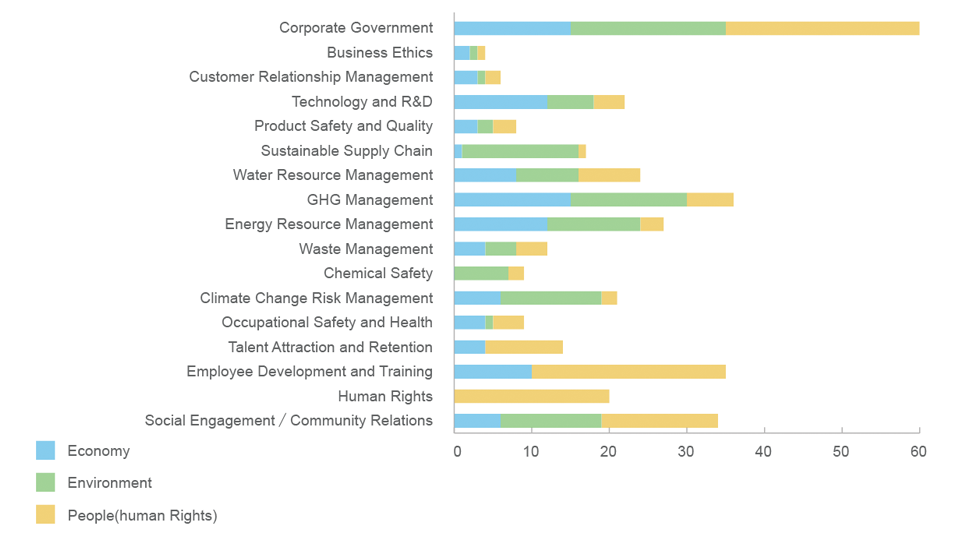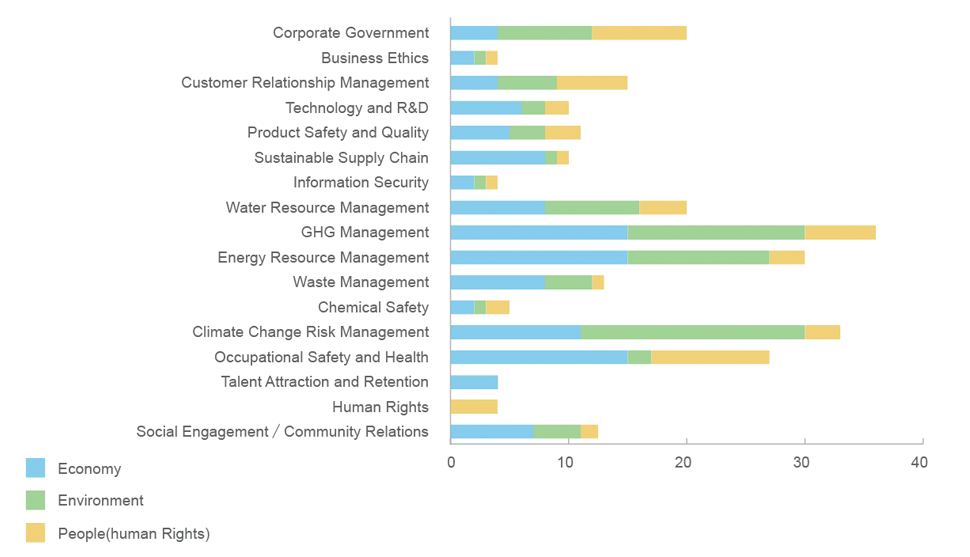| Issues |
Main Content in 2022 |
Possible Human Rights Impact |
Engagement |
Responses from Unimicron |
| Participation |
Consultation |
Information |
Customers To become the best business partner for our customers, Unimicron strives to provide high-quality products and services to build a satisfactory and trusting relationship with our customers.
|
• Corporate Governance
• Risk Management
• GHG Management
• Occupational Safety and Health
• Energy Resource Management
• Water Management
• Human Rights
• Information Security
• Climate Change Risk Management
• Chemical Safety |
• Risk management & contingency plan
• Requirements of RoHS/REACH SVHC
• Hazardous substances free guarantee for products
• Requirements for disclosure of hazardous substances in products
• Obtain OSH Management System certificate by third party
• Implement disaster prevention and emergency response measures
• GHG emission management measures
• Energy resource management measures
• The impact of the revised Environmental and Energy Resources Act on us |
• Failure to properly manage commercial information and personal data and information of customers when dealing with customers. |
• Audit (As needed)
• Hazardous Substance Questionnaire from Customers (GM system, E-mail, daily)
• Certificate of Non-use for Hazardous Substances (GM system, E-mail, irregularly)
• Questionnaire Survey (As needed)
• Information Security Industry Association
• Information Security Assessment from Customer (As needed) |
• Telephone /E-mail (Aperiodic) |
• RBA Platform (Annually)
• Documents Reviewed by Customers (As needed) |
• Assess risk by following the "Risk Management Operating Procedures".
• Reply to customer survey form (regarding REACH) twice a year.
• Confirm the materials test report from 3rd party’s lab.
• Provide certification of Non-use for Hazardous Substances.
• Maintain the verification of the OSH management by 3rd party.
• Maintain regular operation of Fire-protection, life safety systems, and fire drills.
• Continue to implement occupational safety and project audits.
• Set GHG reduction plans and targets.
• Set energy resource management targets.
• Through industry exchanges and sharing, strengthen the blind spots of the Company's internal protection mechanism, and improve the level of information security assessment to meet customer requirements. |
Government Unimicron complies with the environmental and corporate governance regulations issued by the Government and implements them in its operations.
|
• Corporate Governance
• Occupational Safety and Health
• Energy Resource Management
• Water Resources Management
• Human Rights
• Information Security
• Climate Change Risk Management |
• Compliance with fire and OSH laws
• Critical occupational safety or fire incidents
• Participate in OSH seminars
• Reduce water usage
• Reduce energy consumption |
• The occurrence of major OSH hazards will affect the physical and mental health of workers. |
• On-site Audit (As needed)
• Regular Reporting and Notification (As needed, annually) |
|
• The Official Document (As needed) |
• Continue to operate and improve the occupational safety management system.
• Maintain regular operation of Fire-protection, life safety systems, and fire drills.
• Implementing inspection, registration and reporting of OSH, fire prevention, and buildings by following the regulations. Participate in seminars to understand the key of the law changes and revise the SOP.
• Conduct annual internal audits in each Plant, including occupational safety, fire safety, and accident audits, and correct deficiencies.
• Increasing water and energy efficiency and reduce consumption.
• Established in the 2nd quarter of 2022 with a Chief Information Security Officer and a dedicated information security unit (at least 2 personnel). |
Suppliers/Contractors Collaborate with suppliers to promote ESG and enhance supply chain value.
|
• Corporate Governance
• Waste Management
• Occupational Safety and Health
• Human Rights
• Sustainable Supply Chain
• Climate Change Risk Management
• Chemical Safety |
• Understand Unimicron’s requirement for hazardous substance free management
• Supplier compliance with customer or RBA code of conduct
• Fined for violating OSH laws |
• If the supplier does not pay attention to labor human rights, it may cause illegal incidents, which will indirectly affect the goodwill of Unimicron, and affect the willingness of customers to place orders. |
|
|
• Supplier Management Platform (As needed)
• E-mail (As needed)
• Training Course (As needed)
• Audit (As needed) |
• Promote suppliers to meet the requirements of the customer's or RBA Code of Conduct by Supplier Management Platform.
• Strengthen the control of hot work, increase the protection requirements according to the risk classification, and reduce the risk before/during/after the operation.
• Arrange to perform supplier RBA audit every year and track supplier improvement measures.
• Supplier Response to Hazardous Substance Survey Statement/REACH Compliance Statement.
• Chemical suppliers are required to provide SDS and GHS materials in Chinese and English, and contractors are required to participate in hazard notification training and agreement organization to reduce the risk of OSH. |
Employees Talent is the foundation of Unimicron's sustainable development and one of our most important assets.
|
• Corporate Governance
• Occupational Safety and Health
• Water Resources Management
• Human Right
• Talent Attraction and Retention
• Employee Development and Training |
• Comprehensive health management
• Whether the concentration of hazardous chemicals is harmful to health
• No occupational injured
• The actual implementation of accident response and evacuation
• Water risk management |
• Chemicals leak, causing harm to employees’ health.
• Sexual harassment or workplace bullying.
• If overtime is not paid on time, it will affect labor rights and benefits. |
|
• Health Management Center (Quarterly)
• Supervisors (Aperiodic) |
• Employee Opinion Box(As needed)
• Website & Notice Board (As needed)
• Labor-Management Meetings (Quarterly)
• Welfare Committee (Quarterly)
• Training Course (As needed) |
• Through various health promotion events and services, the physical and mental health of each employee is cared for, creating a friendly and safe workplace.
• Implement human rights management measures and related education and training, and provide diversified communication channels for employees.
• Increase requirements for high-risk facilities, machines, environment and operation inspections, to prevent machine operations, human operations and site setting errors.
• Have inter-departmental cooperation to strengthen the acceptance mechanism of new equipment to enhance the intrinsic safety of the machine.
• Add courses on professional and personnel dangerous operations, strengthen skill certification and operation qualification license operations.
• Establish an occupational safety news column and a proposal improvement system, so that employees can receive and brainstorm about occupational safety and health related issues anywhere, and enhance safety awareness.
• Optimize fire protection system and emergency response facilities, and implement maintenance management mechanism.
• Strengthen professional knowledge and capability training, improve the ability to respond to accidents, and reduce direct and indirect losses.
• Planning and conducting the environmental testing strategy regularly.
• Formulate water resources management plans and goals to strengthen water efficiency and cost down. |
Shareholders/Investors Investors and shareholders provide capital, which is the strength of Unimicron's steady growth.
|
• Corporate Governance
• Water Resources Management
• Talent Attraction and Retention
• Climate Change Risk Management
• Chemical Safety |
• Disclose information to external investors to understand the operation
• The impact of climate change and water risks on operations and related mitigation strategies
• Critical occupational safety incidents
• Major ticket violation
• The impact of carbon emissions and water risks on operations and related mitigation strategies |
• If the information is not disclosed in accordance with the law, it will affect the investor's judgment and cause losses, and the investment rights and interests will be damaged.
• Failure to actively address environmental-related issues may affect people's basic human rights such as the right to work, the right to health, and the environmental right. |
• Investment Forum (As needed) |
• Telephone /E-mail (As needed) |
• Shareholders’ Meetings (Annually)
• Institutional Investor Conferences (Half year)
• Annual Reports (Annually)
• Market Observation Post System (As needed) |
• Self-organize institutional investor conferences twice a year and participate in public forum per year.
• Continue to implement and improve the OSH system.
• Disclose CDP's climate change/water information annually and manage the risks of carbon emissions and water use. |
Community/NGOs/Non-Profit Organizations Based on the concept of "taking from society and giving back to society", we listen and respond to the community and cooperate with NGOs to contribute to the community and enhance social influence.
|
• Business Ethics
• GHG Management
• Human Rights
• Social Engagement/Community Relations |
• Support the development of OSH in the industry
• Participate in OSH seminars
• Join regional prevention organizations
• Reduce GHG emissions |
• Accidents or violations of environmental protection issues in the Company will affect the quality of life of local residents. |
• Seminar (As needed)
• Participate in Prevention Organizations (As needed) |
• Telephone (As needed) |
• The Official Document (As needed)
• Unimicron Website (Periodic, Aperiodic) |
• Continuous operation, effectiveness, and improvement of OSH management system.
• Participate in the activities of industry organizations.
• Participate in seminars related to OSH issues.
• Participate in regional prevention organizations.
• Implement and disclose GHG reduction measures.
• Continuously conduct environmental protection activities in each plant to maintain the relationship with the community. |
Academic Institutions We collaborate with academic institutions to develop new technologies, and through industry-academia cooperation to strengthen our patent and nurture R&D talents
|
• Technology and R&D
• Talent Attraction and Retention |
• Industry-Academia Collaborative Research Project
• Cooperative Education Program
• Summer Internship Program |
• Failure to provide sound workplace education and training will cause students to lose confidence. |
• Campus Recruiting Events (Periodic) |
• Telephone /E-mail (As needed) |
• The Official Document (As needed)
• Unimicron Website (Aperiodic) |
• Build long-term partnerships with universities.
• Annual Cooperative Education Program, with a total of 12 schools and 110 students in 2022. |



